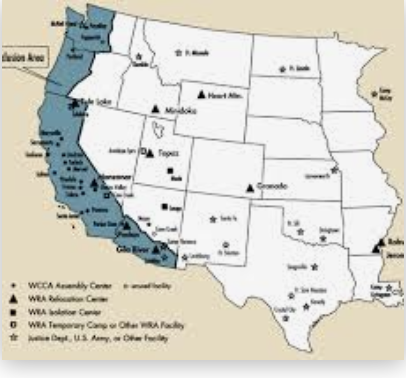
RESTRICTED ZONE
All of 1/16th Japanese Heritage
removed from restricted zone
110,000 INCARCERATED IN 10 REMOTE AREA CAMP COMMUNITIES
We were living inland, beyond the 400 miles from the Pacific Coast restricted area. Four years previous to December 7, 1941, six households, 11 adults and 15 children, led by my Grandpa K Tsukamaki; migrated from Seattle to Eastern Oregon and Western Idaho’s Treasure Valley. It was carefully planned because of fears of discrimination along the way and possible breakdown incidents. Like the pioneers with the covered wagons moving west, this caravan traveled east in motor vehicles. They helped each other get established, in row-crop farming, in this new community in 1937 and increased the population of Vale, Oregon, around 1000 at that time.
My Uncle Frank Tsukamaki told me, “I was 20-years-old. Life was dramatically changed in every way as America prepared for war and the possibility that the West Coast cities would be targets. We had found better farming ground in Notus, Idaho, across the Snake river from Vale and were raising onions. But it was winter so my brother, Ben, was in Los Angeles learning the grocery business. Ben was being trained at a friend of Dad’s, Jow family, grocery store on Prairie Avenue.
When President Roosevelt signed the executive order 9066, February 19, 1942, Dad asked me to drive the 800 miles to Los Angeles and pick Ben up. It was scary! Ben was in Inglewood, CA, where they had the aircraft factory. All of that area, Hollywood Race Track and stuff was full of military trucks. They were even from out of state with license plates from New Jersey, New York and east. And right there they had the sand bags!
I had to get a permit to come back past the restricted zone to Idaho. Ben had become good friends with their son, Bill Jow, who was going to UCLA. Bill’s high school friend’s father was Mayor of Inglewood. So Bill asked that friend, the mayor, who knew Western Defense commander General DeWitt. We were able to get a permit to travel right away.
Well anyway, Ben and I packed up our things and left LA. We hit Sacramento and a military policeman stopped us, so we showed him the permit. He couldn’t believe DeWitt’s signature. So they held us for a few hours until they contacted DeWitt’s headquarters.
The roads at that time were not that great and narrow. There, where it was the Donner Summit and a high narrow pass, they had a whole bunch of anti-aircraft guns. It was a weird feeling.”
“I AM JAPANESE AMERICAN!”
Especially at the start of WWII with Japan, many Chinese wanted to make sure they weren’t automatically classed as Japanese. There were articles in popular magazines like “LIFE” and newspapers pointing out facial characteristic differences between Japanese and Chinese. Some Chinese individuals chose to wear buttons that read, “I am Chinese”.
Frank continued, “These practices were irritating to me and most of us Japanese would rather been discriminated than to say we were Chinese. There was a mutual feeling of enmity between Japanese and Chinese.
I particularly remember one incident. I was in LA and got low on gas. There was this Standard station in Inglewood. I stop by and was going to gas up. ‘White Attendant’ walks up to me and say, ‘What nationality are you?’ I so, I almost said I was Chinese American, but luckily I decide to tell the truth and say, ‘I’m Japanese American.’
He told me, ‘I hate how they act. Those Chinks, I hate them.’”